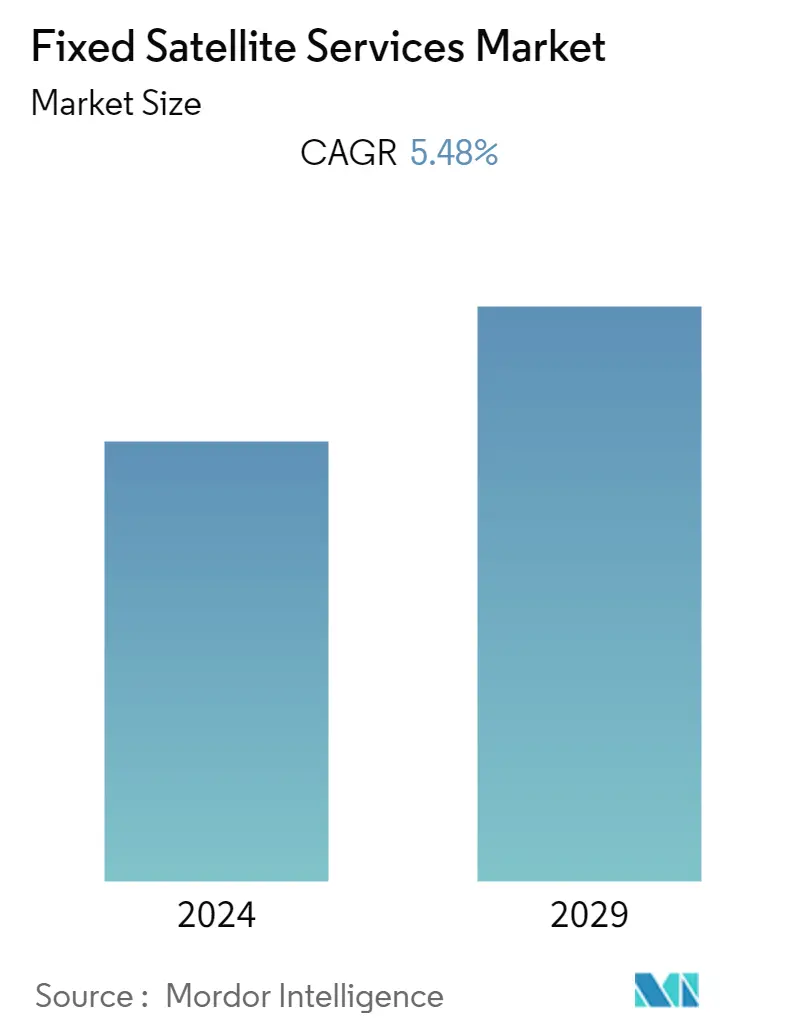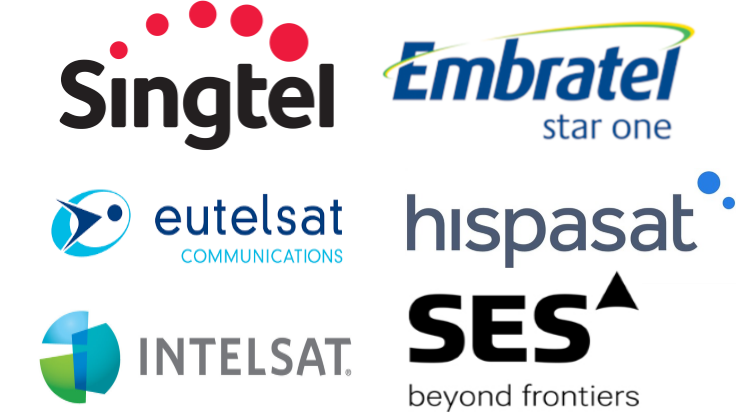Market Size of Fixed Satellite Services Industry

| Study Period | 2019 - 2029 |
| Base Year For Estimation | 2023 |
| CAGR | 5.48 % |
| Fastest Growing Market | Asia Pacific |
| Largest Market | North America |
| Market Concentration | High |
Major Players
*Disclaimer: Major Players sorted in no particular order |
Fixed Satellite Services Market Analysis
The fixed satellite services market was valued at USD 22.46 billion in 2020 and is projected to reach USD 27.15 billion by the end of 2026, registering a CAGR of 5.48% during the forecast period (2021 - 2026).
- Fixed satellite services (FSS) use ground equipment at set locations to receive and transmit satellite signals. Fixed satellite services generally have a low power output and larger dish-style antennas are required for reception. Also, the satellites used for fixed service require less power than direct broadcasting satellites (DBS).
- The fixed satellite service market is expected to grow significantly over the forecast period, owing to the rise in the extensive use of data communications and increasing demand for high-speed internet.
- High capital investment and increasing use of fiber optic transmission cables are some of the major factors restraining the adoption of the fixed satellite services. Also, the stringent government regulation related to the market and limited orbital locations can also effect the entrance of new players into the studied market.
- The demand for fixed satellite services is also rising from the enterprise segment. In July 2018, Gilat Telecom announced that it was chosen as a service provider for Iridium Certus for land-mobile applications and can now offer customers a wider variety of fixed connectivity solutions.
Fixed Satellite Services Industry Segmentation
Fixed satellite services (FSS) provides a high-speed connection to the end users by making use of very small aperture terminal (VSAT) technology. FSS systems are positioned in a fixed strategic location and the coverage area extends up to several square miles. FSS systems are used in various sectors like commercial, aerospace and defense, media but the telecom industry is the prime user among all.
| By Type of Services | |
| Transponder Agreements | |
| Managed Services |
| By End-user Vertical | |
| Government | |
| Commercial | |
| Aerospace and Defense | |
| Media | |
| Other End-users Verticals |
| Geography | |
| North America | |
| Europe | |
| Asia-Pacific | |
| Latin America | |
| Middle East & Africa |
Fixed Satellite Services Market Size Summary
The fixed satellite services (FSS) market is poised for significant growth, driven by the increasing demand for data communications and high-speed internet. FSS utilizes ground equipment at fixed locations to transmit and receive satellite signals, typically requiring larger dish-style antennas and operating with lower power output compared to direct broadcasting satellites. The market's expansion is supported by the rising penetration of 5G technology, which relies on fixed satellites for connectivity. However, challenges such as high capital investment, competition from fiber optic transmission, and stringent government regulations may hinder market adoption. The enterprise segment's demand for FSS is also on the rise, with companies like Gilat Telecom expanding their service offerings to include a broader range of fixed connectivity solutions.
Regionally, the market is expected to experience rapid growth, particularly in areas with a booming telecom sector and increased investment in satellite services. Notable developments include China's launch of a communication satellite for global internet services and India's deployment of the GSAT-31 satellite to enhance its communication capabilities. The competitive landscape of the FSS market is dominated by a few major players, such as Intelsat SA and Eutelsat Communications, who are actively seeking to expand their international presence through strategic collaborations and acquisitions. These efforts are aimed at strengthening their market position and enhancing their service offerings in the fixed satellite services domain.
Fixed Satellite Services Market Size - Table of Contents
-
1. MARKET DYNAMICS
-
1.1 Market Overview
-
1.2 Introduction to Market Drivers and Restraints
-
1.3 Market Drivers
-
1.3.1 Increasing DTH Subscriptions
-
1.3.2 Increasing Demand from Corporate Enterprise and Growing use of Transponders in the Media and Entertainment Industry
-
-
1.4 Market Restraints
-
1.4.1 High Capital Investment and Increasing Use of Fiber Optic Transmission Cables
-
1.4.2 Regulatory Constraints and Limited Orbital Locations
-
-
1.5 Industry Attractiveness - Porter's Five Forces Analysis
-
1.5.1 Threat of New Entrants
-
1.5.2 Bargaining Power of Buyers/Consumers
-
1.5.3 Bargaining Power of Suppliers
-
1.5.4 Threat of Substitute Products
-
1.5.5 Intensity of Competitive Rivalry
-
-
-
2. MARKET SEGMENTATION
-
2.1 By Type of Services
-
2.1.1 Transponder Agreements
-
2.1.2 Managed Services
-
-
2.2 By End-user Vertical
-
2.2.1 Government
-
2.2.2 Commercial
-
2.2.3 Aerospace and Defense
-
2.2.4 Media
-
2.2.5 Other End-users Verticals
-
-
2.3 Geography
-
2.3.1 North America
-
2.3.2 Europe
-
2.3.3 Asia-Pacific
-
2.3.4 Latin America
-
2.3.5 Middle East & Africa
-
-
Fixed Satellite Services Market Size FAQs
What is the current Fixed Satellite Services Market size?
The Fixed Satellite Services Market is projected to register a CAGR of 5.48% during the forecast period (2024-2029)
Who are the key players in Fixed Satellite Services Market?
Eutelsat Communications, Telesat Holdings, Singapore Telecommunications Ltd (Singtel), SES SA and Intelsat SA are the major companies operating in the Fixed Satellite Services Market.

